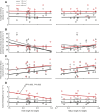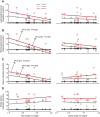Does human foot anthropometry relate to plantar flexor fascicle mechanics and metabolic energy cost across various walking speeds?
- PMID: 37092255
- PMCID: PMC10226764
- DOI: 10.1242/jeb.245113
Does human foot anthropometry relate to plantar flexor fascicle mechanics and metabolic energy cost across various walking speeds?
Abstract
Foot structures define the leverage in which the ankle muscles push off against the ground during locomotion. While prior studies have indicated that inter-individual variation in anthropometry (e.g. heel and hallux lengths) can directly affect force production of ankle plantar flexor muscles, its effect on the metabolic energy cost of locomotion has been inconclusive. Here, we tested the hypotheses that shorter heels and longer halluces are associated with slower plantar flexor (soleus) shortening velocity and greater ankle plantar flexion moment, indicating enhanced force potential as a result of the force-velocity relationship. We also hypothesized that such anthropometry profiles would reduce the metabolic energy cost of walking at faster walking speeds. Healthy young adults (N=15) walked at three speeds (1.25, 1.75 and 2.00 m s-1), and we collected in vivo muscle mechanics (via ultrasound), activation (via electromyography) and whole-body metabolic energy cost of transport (via indirect calorimetry). Contrary to our hypotheses, shorter heels and longer halluces were not associated with slower soleus shortening velocity or greater plantar flexion moment. Additionally, longer heels were associated with reduced metabolic cost of transport, but only at the fastest speed (2.00 m s-1, R2=0.305, P=0.033). We also found that individuals with longer heels required less increase in plantar flexor (soleus and gastrocnemius) muscle activation to walk at faster speeds, potentially explaining the reduced metabolic cost.
Keywords: Biomechanics; Locomotion; Muscle.
© 2023. Published by The Company of Biologists Ltd.
Conflict of interest statement
Competing interests The authors declare no competing or financial interests.
Figures




Similar articles
-
Contributions to the understanding of gait control.Dan Med J. 2014 Apr;61(4):B4823. Dan Med J. 2014. PMID: 24814597 Review.
-
Adding Stiffness to the Foot Modulates Soleus Force-Velocity Behaviour during Human Walking.Sci Rep. 2016 Jul 15;6:29870. doi: 10.1038/srep29870. Sci Rep. 2016. PMID: 27417976 Free PMC article.
-
Gearing Up the Human Ankle-Foot System to Reduce Energy Cost of Fast Walking.Sci Rep. 2020 May 29;10(1):8793. doi: 10.1038/s41598-020-65626-5. Sci Rep. 2020. PMID: 32472010 Free PMC article.
-
In vivo fascicle behavior of the flexor hallucis longus muscle at different walking speeds.Scand J Med Sci Sports. 2017 Dec;27(12):1716-1723. doi: 10.1111/sms.12810. Epub 2017 Feb 3. Scand J Med Sci Sports. 2017. PMID: 28156022
-
Powered ankle exoskeletons reveal the metabolic cost of plantar flexor mechanical work during walking with longer steps at constant step frequency.J Exp Biol. 2009 Jan;212(Pt 1):21-31. doi: 10.1242/jeb.017269. J Exp Biol. 2009. PMID: 19088207
References
Publication types
MeSH terms
Grants and funding
LinkOut - more resources
Full Text Sources
Medical

